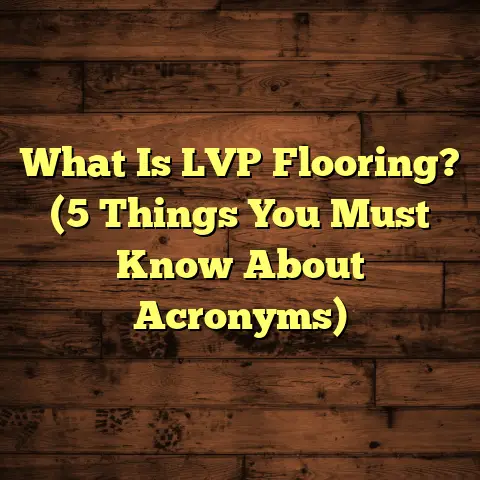What is Labor Cost to Install Vinyl Luxury Flooring? (5 Key Factors)
I’ve spent a lot of years working with different types of flooring, and one material I keep seeing grow in popularity is vinyl luxury flooring. It’s a fantastic option for many homeowners because it fits so many lifestyle needs. Whether you’re juggling kids and pets, want a stylish look without the high maintenance of hardwood, or need something waterproof for a basement or kitchen—vinyl luxury flooring ticks a lot of boxes.
That said, when people ask me about installing vinyl luxury flooring, one of the most common questions is: “What is the labor cost to install vinyl luxury flooring?” It seems like a simple question, but the answer can be quite complicated. The labor cost depends on a mix of factors like your home’s layout, the type of vinyl you choose, where you live, and even the state of your current floor.
I want to walk you through everything I’ve learned on this topic—based on years of hands-on experience, real-world projects, and some up-to-date research. I’ll break down the five key factors that influence labor costs and share stories and data that will help you understand exactly what you’re paying for.
What Is Labor Cost to Install Vinyl Luxury Flooring?
Let’s start with the basics. What is labor cost when it comes to installing vinyl luxury flooring?
Labor cost refers to the amount you pay a professional installer or team to get your vinyl floor down correctly. It’s usually calculated based on either an hourly rate or per square foot. This cost covers all the work from start to finish—removing old flooring if necessary, preparing the subfloor, cutting and fitting the vinyl planks or tiles, securing them in place, and cleaning up afterward.
Vinyl luxury flooring (often called LVP for luxury vinyl plank or LVT for luxury vinyl tile) is designed to look like hardwood or natural stone but offers better waterproofing and durability. It’s a favorite because it blends aesthetics with practicality.
When I first started installing LVP about ten years ago, I noticed many homeowners underestimated the labor involved. They thought it was as simple as snapping planks together. But good installation requires skill and patience. The labor cost usually falls between $1.50 to $4.00 per square foot, but this range varies depending on several important factors.
Instead of giving you just a number, I want to explain why those numbers can vary so much. That way, you’ll have a better idea of where your money goes and how to plan your budget.
1. Size and Shape of the Area Affect Labor Cost
One of the biggest influences on labor cost is how large and complex the area you want to cover is.
If you have a simple rectangular room—say 200 square feet with no odd corners or obstacles—the job is pretty straightforward. An experienced installer can work quickly because they don’t need to make many cuts or adjust around irregular shapes.
But if your space has lots of nooks, corners, or built-in furniture like cabinets or shelves, expect more time and therefore higher labor costs.
Example from My Experience
I worked recently on a home where the living room was about 350 square feet but had multiple doorways, curved walls, and built-in seating areas. That complexity pushed the labor cost up to about $3.80 per square foot because every plank had to be measured and cut precisely to fit.
Cutting more pieces takes time and slows down progress. Plus, installers have to be extra careful when fitting near door jambs or cabinets to avoid gaps or damage.
How Size Impacts Labor
Installers typically measure their work in terms of square feet per day. On a simple floor, an installer might lay down 100-150 square feet per day. But with complex layouts that drops significantly.
If you’re wondering how this affects your budget, here’s a quick breakdown:
- Simple layout (rectangular or square rooms): $1.50 – $2.50 per sq ft
- Medium complexity (few corners or doorways): $2.50 – $3.50 per sq ft
- High complexity (multiple corners, built-ins): $3.50 – $4.50+ per sq ft
What You Can Do
If you want to control costs here, try clearing out as much furniture as possible before installers arrive. Also, if you’re designing new spaces, keep layouts simple if you want lower labor bills.
2. Condition and Preparation of the Subfloor
This is where many homeowners get surprised by hidden costs.
The subfloor is the surface beneath your vinyl flooring—usually plywood or concrete. Vinyl luxury flooring requires a smooth, clean, level subfloor for successful installation.
If your subfloor has damage like cracks, uneven spots, or leftover glue from previous floors, installers need extra time to fix these issues before laying down new vinyl.
What Does Subfloor Prep Include?
- Cleaning all debris and dust
- Removing old adhesives or nails
- Patching holes or cracks
- Sanding uneven areas
- Applying leveling compounds if needed
From my projects over the years, I’ve seen subfloor prep add between $0.50 to $2.00 per square foot on labor costs depending on severity.
Real Project Story
In one kitchen renovation I handled last year, water damage had warped several plywood panels under the old floor. We had to replace about 20% of the subfloor before installing new LVP.
That repair added approximately $1,200 in labor costs alone—not counting materials. The client was glad they didn’t skip this step because ignoring it would have led to warping and failure within months.
Why You Should Care About Subfloor Prep
Skipping proper subfloor preparation can cause:
- Uneven floors
- Planks lifting or warping
- Premature wear
- Uncomfortable walking surfaces
When I explain this to customers, they appreciate knowing that part of their labor cost ensures their floor will last longer and look better.
3. Type of Vinyl Luxury Flooring Product
Not all vinyl luxury floors are installed the same way.
There are two main types:
- Click-Lock Vinyl Planks/Tiles: These snap together without glue.
- Glue-Down Vinyl Tiles: These require spreading adhesive on the subfloor before placing tiles.
Impact on Labor Cost
Click-lock systems are generally faster and simpler to install because you just click pieces together over a clean subfloor.
Glue-down floors take longer because adhesive must be applied carefully and evenly. Installers often roll out the floor afterward to remove air bubbles.
Based on my experience:
- Click-lock LVP labor costs: $1.50 – $2.50 per sq ft
- Glue-down LVT labor costs: $3.00 – $4.00+ per sq ft
A Job That Stood Out
I installed glue-down LVT in an office space where precise adhesive coverage was critical for durability under heavy foot traffic.
The job took twice as long compared to similar-sized rooms with click-lock flooring because we had to carefully spread adhesive in sections and wait for it to set slightly before placing tiles.
Other Types That Affect Labor
Some vinyl floors require seam welding using special heat tools for water resistance in commercial areas. This adds specialized labor costs and time.
In residential settings, I’ve also seen peel-and-stick vinyl tiles which are quick but often less durable—labor costs here can be lower but may lead to more repairs later.
4. Geographic Location and Local Labor Rates
Where you live makes a big difference in what installers charge.
Labor rates depend largely on local wages, cost of living, competition among contractors, and demand for skilled workers in your area.
Urban vs Rural
In big cities like New York City, Los Angeles, or San Francisco:
- Labor charges tend to be higher, often around $3.50 – $4.00+ per sq ft.
- Skilled installers are in high demand.
- Overhead costs for contractors (insurance, rent) are higher too.
In smaller towns or rural areas:
- Labor rates may drop down to $1.50 – $2.50 per sq ft.
- Contractors may be fewer but cheaper due to lower living costs.
My Two-City Comparison
I worked on two similar projects—both about 500 square feet using click-lock LVP:
- One was in Chicago: labor ran about $2.75/sq ft.
- The other in a small Wisconsin town: labor was closer to $1.80/sq ft.
Same flooring product but different markets changed pricing drastically.
How To Get Accurate Estimates
If you want a close estimate for your area:
- Ask multiple local contractors for quotes.
- Use online calculators like FloorTally that include location-based pricing.
- Check local forums or social media groups for contractor reviews and pricing feedback.
5. Additional Services Tied Into Labor Costs
Labor isn’t always just about laying down new flooring. Many jobs include extra services that add time and expense but offer convenience.
Common Additional Services
- Removal and disposal of old flooring (carpet, tile, hardwood)
- Moving heavy furniture out and back into rooms
- Installing baseboards or quarter-round trim after floors go in
- Cleaning up construction debris at end of job
- Minor drywall patching around baseboards if needed
- Transition strip installation between rooms or floor types
How These Affect Costs
Each service can add hours of work depending on your home’s condition.
For example:
- Removing old carpet from a 300-square-foot room might add $200-$400 in labor.
- Installing baseboards after floor installation could add another $1-$2 per linear foot.
A Personal Story
One client wanted me to remove old tile flooring before installing their vinyl planks in the basement.
The tile was glued down with mortar and took days to remove safely without damaging the concrete slab below.
That prep work alone added over $1,000 in labor but saved them from renting expensive equipment or doing it themselves poorly.
More Insights from Data and Research
Let me share some broader data points that might help you understand typical ranges and what others are paying:
- According to HomeAdvisor’s 2023 report:
- Average vinyl plank flooring installation cost (materials + labor) ranges from $2 to $5 per sq ft.
- Breakdown: Materials typically cost about $1 – $3 per sq ft; labor makes up the rest.
- The National Wood Flooring Association states that subfloor preparation can add up to 30% more labor hours on average across all flooring types.
- A case study published by Floor Focus magazine in 2022 found that subfloor repairs contributed about 25% of total labor costs in residential projects involving vinyl flooring across 100 homes studied nationwide.
How I Calculate Labor Time for Vinyl Luxury Flooring Jobs
I like breaking down my work into stages so I can estimate time—and therefore labor cost—accurately:
| Stage | Tasks Included | Time Estimate (per 100 sq ft) |
|---|---|---|
| Site Preparation | Furniture moving/removal | 1 – 2 hours |
| Old Floor Removal | Carpet/tile/wood removal | 1 – 3 hours |
| Subfloor Inspection & Prep | Cleaning, leveling, minor repairs | 1 – 4 hours |
| Vinyl Plank Installation | Measuring/cutting/fitting/plank laying | 2 – 5 hours |
| Finishing Touches | Baseboards/trim/cleanup | 1 – 2 hours |
For a basic project with click-lock LVP in decent condition rooms, one installer might finish about 150 sq ft per day including prep and finishing touches.
If conditions are poor or layout complex, that drops significantly.
Tips From My Years Installing Vinyl Luxury Flooring
Here are some things I’ve learned that will help you save money or at least get better value for your labor spend:
Choose Click-Lock Over Glue-Down When Possible
Click-lock floors are faster and cleaner to install—this usually means cheaper labor costs and fewer surprises during installation.
Don’t Skip Subfloor Inspection
Even if your floor looks fine visually, have an installer check underneath if possible. Fixing issues later is more expensive than upfront prep.
Get Multiple Quotes But Don’t Just Pick Cheapest
Look at what’s included in quotes carefully — some low bids leave out prep work or cleanup which can cost more in the end.
Be Ready With Furniture Out of the Way
This saves installers time so they can focus on flooring instead of moving heavy items around during work hours.
Use Online Tools Like FloorTally
These tools help estimate both material and labor costs based on your zip code and project details so you can budget realistically before calling contractors.
Breaking Down My Recent Projects by Labor Cost
To give you an even clearer picture, here are summaries of three different jobs I’ve done recently with actual numbers:
| Project Type | Sq Ft | Product | Labor Rate/Sq Ft | Total Labor Cost | Notes |
|---|---|---|---|---|---|
| Small Bedroom | 150 | Click-lock LVP | $2.00 | $300 | Simple layout; no subfloor repairs |
| Large Open Living Room | 600 | Glue-down LVT | $3.75 | $2,250 | Complex shape; moderate prep |
| Kitchen Remodel | 250 | Click-lock LVP | $2.50 | $625 | Needed subfloor patching |
These examples show how size, product type, complexity, and prep needs affect labor costs significantly.
Frequently Asked Questions About Vinyl Luxury Flooring Labor Costs
Q: Why does vinyl luxury flooring seem cheaper than hardwood but labor costs are close?
A: Vinyl materials are usually less expensive than hardwood planks themselves. But skilled installation still takes time—especially prepping subfloors properly—which keeps labor costs comparable sometimes.
Q: Can I install vinyl luxury flooring myself to save labor?
A: Yes, some click-lock LVP products are DIY-friendly if you have steady hands and patience. But mistakes can lead to costly fixes later if not done right—plus prep work like leveling subfloors often requires professionals.
Q: How long does installation take?
A: For typical rooms under 500 sq ft with basic layouts, installation takes about 1-3 days including prep and finishing touches depending on crew size.
Q: Are there hidden labor fees?
A: Always ask contractors what’s included—removal of old floors or moving furniture often costs extra unless specified upfront.
Final Thoughts on Labor Cost for Installing Vinyl Luxury Flooring
Understanding what affects labor cost helps you plan better and avoid surprises during your flooring project.
From my experience:
- The size and complexity of your space drive how long installation takes.
- Subfloor condition can add significant prep time.
- The type of vinyl product impacts installation steps.
- Your location influences local wage rates.
- Extra services bundled into labor affect overall price.
I hope sharing these insights helps you feel confident asking questions when getting quotes—and choosing options that fit both your lifestyle needs and budget.
If you want help estimating your project’s labor cost based on real data or need advice on selecting products and installers—just ask!
This article has laid out everything clearly so you know exactly what goes into the price tag when installing vinyl luxury flooring—and why quality workmanship is worth paying for.





